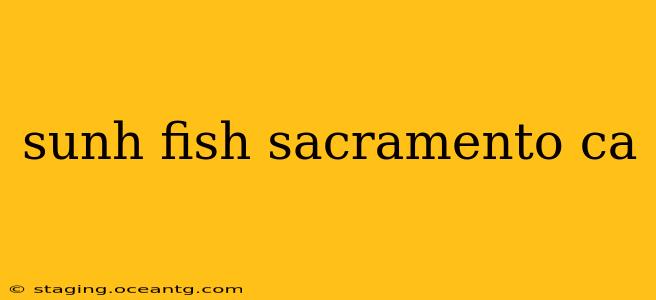Sacramento, California, boasts a diverse range of fish species, and among them, sunfish are a popular target for anglers of all skill levels. This comprehensive guide dives into everything you need to know about sunfish fishing in the Sacramento area, answering common questions and providing valuable tips for a successful fishing trip.
What are the best places to catch sunfish in Sacramento?
Sacramento and its surrounding areas offer several excellent locations for sunfish fishing. Many smaller lakes, ponds, and slow-moving sections of rivers hold healthy populations. Specific locations are often kept secret by experienced anglers, but exploring local parks with water features is a great starting point. Checking with local fishing supply stores or online fishing forums can provide valuable insider tips on productive spots. Remember always to check for any fishing regulations or permits required for specific locations.
What kind of sunfish can I expect to find in Sacramento?
Several species of sunfish are found in Sacramento's waters. Common species include bluegill, redear sunfish (shellcracker), and green sunfish. These fish inhabit various water bodies, from quiet backwaters to weedy ponds. Their presence often indicates a healthy aquatic ecosystem.
What is the best bait for sunfish in Sacramento?
Sunfish are opportunistic feeders, and a variety of baits can prove effective. Popular choices include:
- Worms: Nightcrawlers, redworms, and mealworms are all excellent choices and readily available at most bait shops.
- Insects: Crickets, grasshoppers, and even ants can be highly effective, particularly during the warmer months.
- Small artificial lures: Tiny jigs, spinners, and poppers can be used successfully, especially for more active fish.
- Corn: Sweet corn kernels are another popular and effective bait.
What time of year is best for sunfish fishing in Sacramento?
Sunfish are generally most active during the warmer months, from spring through fall. Water temperatures play a significant role in their feeding activity. The peak seasons are typically late spring and early summer, and again in the early fall.
What are the size and bag limits for sunfish in Sacramento?
Fishing regulations vary depending on the specific water body and the time of year. Always check the current California Department of Fish and Wildlife (CDFW) regulations before you fish. Their website provides detailed information on size and bag limits, as well as licensing requirements. Respecting these regulations helps ensure the sustainability of fish populations for future generations.
What type of fishing tackle is best for catching sunfish in Sacramento?
Sunfish are not large fish, so lightweight tackle is usually sufficient. A light spinning rod or ultralight rod paired with a small reel is ideal. Use a thin monofilament or fluorocarbon line, typically 4-6 pound test. Small hooks are crucial, sized appropriately for your chosen bait.
Are there any special techniques for catching sunfish in Sacramento?
While sunfish can be caught using simple methods, some techniques can improve your chances of success. These include:
- Fishing near cover: Sunfish often hide in weeds, submerged logs, or other structures. Targeting these areas increases your chances of finding feeding fish.
- Using bobbers: Bobbers help keep your bait at the desired depth and indicate when a fish takes the bait.
- Quiet presentation: Sunfish are easily spooked, so approach your fishing spot calmly and quietly.
Where can I find more information on fishing regulations in Sacramento?
The California Department of Fish and Wildlife (CDFW) website is the best source for the most up-to-date fishing regulations. Their website provides detailed information on licensing requirements, size and bag limits, and fishing regulations for various water bodies across California, including Sacramento.
By following these tips and researching specific locations, you can significantly increase your chances of enjoying a successful sunfish fishing adventure in the Sacramento area. Remember to always practice responsible fishing and respect the environment.
